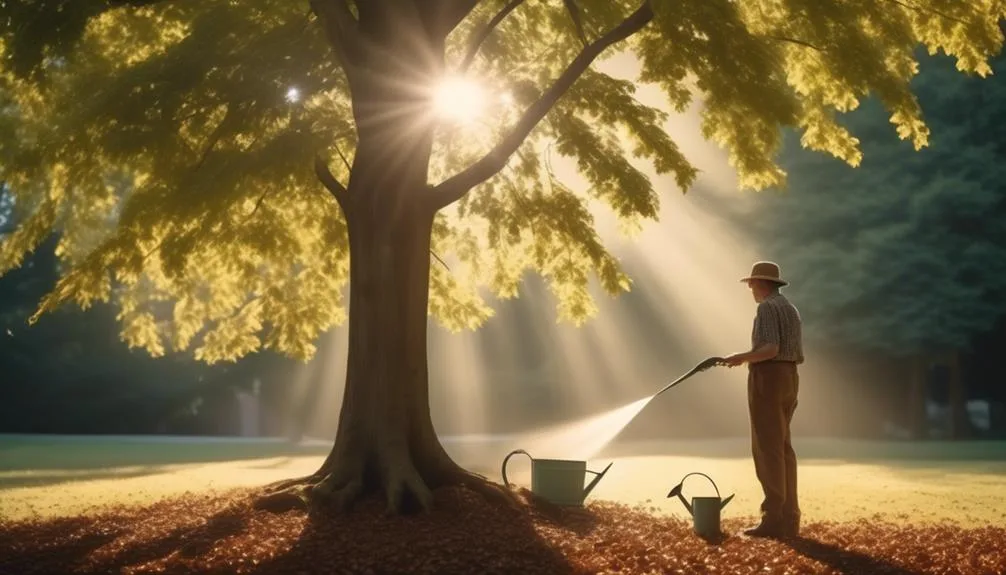Watering hickory trees is more than just giving them a drink. It's a crucial part of their care, impacting their health and growth. How can you ensure they get the right amount of water without overdoing it?
Let's explore the key aspects of properly watering hickory trees to keep them healthy and thriving.
Watering Schedule
To ensure the health and vitality of your hickory trees, it's essential to establish a consistent watering schedule based on their specific needs. Understanding the watering frequency is crucial for the proper care of hickory trees.
During the growing season, hickory trees generally require about 1 inch of water per week, either from rainfall or supplemental watering. However, in hot and dry conditions, they may need additional hydration. It's important to monitor the soil hydration levels to ensure it remains consistently moist but well-drained.
When watering, focus on the tree's root zone, which extends about 1.5 times the distance from the trunk to the drip line. By adhering to a regular watering schedule and monitoring soil moisture, you can effectively support the health and growth of your hickory trees.
Proper Irrigation Techniques
Maintain the health and vitality of your hickory trees by employing proper irrigation techniques that ensure consistent soil moisture and support their growth. To achieve this, consider implementing the following techniques:
- Drip Irrigation: Install a drip irrigation system to deliver water directly to the tree's root zone, minimizing water loss through evaporation and ensuring efficient water usage.
- Mulch Application: Apply a layer of organic mulch around the base of the hickory trees to help retain soil moisture, regulate soil temperature, and suppress weed growth.
- Watering Schedule: Establish a regular watering schedule, especially during dry periods, to supplement natural rainfall and maintain adequate soil moisture levels for healthy hickory tree growth.
Soil Moisture Monitoring
Ensure optimal soil moisture levels for your hickory trees by regularly monitoring and adjusting their water intake based on the specific needs of each tree. One effective way to monitor soil moisture is by using a soil moisture meter, which can provide accurate readings and help you determine the right watering schedule for your trees. Additionally, mulching around the base of your hickory trees offers various benefits, including enhanced water retention. The table below illustrates the benefits of mulching for soil moisture management:
| Mulching Benefits | Description |
|---|---|
| Water Retention | Helps soil retain moisture, reducing the frequency of watering. |
| Insulation | Acts as insulation, protecting the soil from extreme temperatures. |
| Weed Suppression | Prevents weed growth, allowing moisture to be used by hickory trees. |
Deep Root Watering
Consider utilizing a deep root watering method to ensure proper hydration for your hickory trees. This technique involves delivering water directly to the root zone, promoting deep root development and overall tree health. Deep root watering is particularly beneficial during dry periods when surface watering may not reach the roots effectively.
- Effective Hydration: Deep root watering ensures that water reaches the deeper layers of soil where the tree's roots can access it, promoting optimal hydration.
- Encourages Root Development: By directing water deep into the soil, this method stimulates the roots to grow downward in search of moisture, leading to a stronger and more resilient root system.
- Conserves Water: Unlike surface watering, deep root watering reduces water wastage by targeting the root zone, maximizing the water's effectiveness for the tree's benefit.
Seasonal Considerations
When transitioning to seasonal considerations, it's important to adjust your deep root watering method to accommodate changing weather patterns and the specific hydration needs of your hickory trees.
During the hot summer months, hickory trees require more frequent watering to maintain their health and vigor. As temperatures rise, the soil tends to dry out more quickly, necessitating an increase in watering frequency.
Conversely, in the cooler fall and winter months, the watering frequency should be reduced as the trees' water requirements decrease.
Monitoring the moisture levels in the soil is crucial to ensure your hickory trees receive the appropriate amount of water throughout the year.
Conclusion
Incorporating these watering practices will help hickory trees thrive, ensuring their long-term health and vitality. By maintaining a consistent watering schedule, employing proper irrigation methods, and considering seasonal adjustments, you can provide the optimal care for your hickory trees.
With these thoughtful practices, your hickory trees will continue to flourish, enriching your surroundings for years to come. Keep nurturing their growth with these simple yet effective techniques.
Mark Hoffman is a dedicated arborist and tree care specialist with over a decade of experience. His love for trees began when he visited Yosemite National Park as a teenager and was awestruck by the giant sequoias. Mark pursued his passion by studying forestry at Michigan Technological University, where he earned a Bachelor of Science degree.
Since then, he has worked tirelessly in the field of arboriculture, helping to preserve and protect trees in his community. His expertise and dedication have made him a respected leader in the industry and a valuable resource for anyone seeking advice on tree care.
